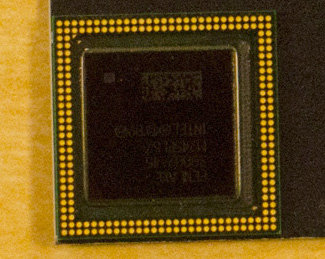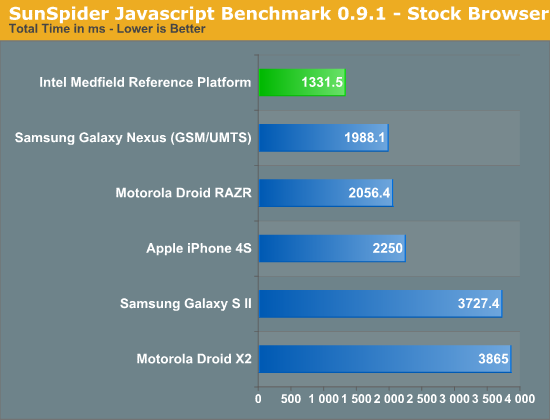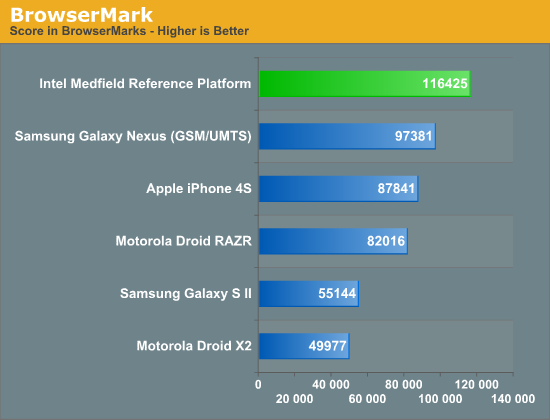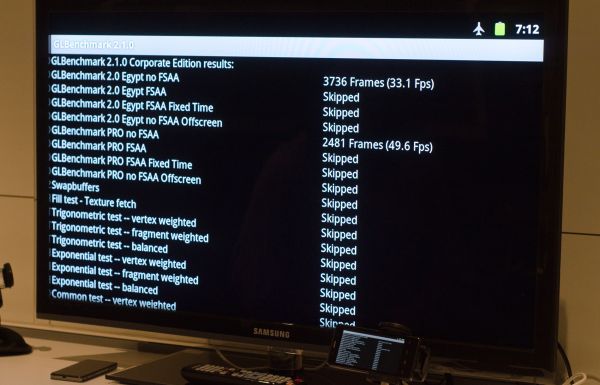Intel's Medfield & Atom Z2460 Arrive for Smartphones: It's Finally Here
by Anand Lal Shimpi on January 10, 2012 8:00 PM ESTIt's here. Intel's first smartphone SoC that you'll actually be able to buy in a device before the end of the year. The platform is called Medfield and Paul Otellini just announced its first device partners.
Medfield starts out as a bonafide mobile SoC. Whereas Moorestown was a "two-chip" solution, Medfield is just one - the Penwell SoC:

The SoC is only available in a PoP (Package on Package) configuration measuring 12mm x 12mm. Intel wouldn't give out a die size but it did show me a Penwell sample without the stacked DRAM:

Since I know the measurements of the package I could estimate the dimensions of the silicon itself. My math worked out to be around 62mm^2. That's larger than a Tegra 2-class SoC, but smaller than Tegra 3 or Apple's A5. The diagram of its high level architecture above helps explain why.
There's only a single version of Medfield being announced today: the Intel Atom Z2460. The Z2460 features a single Atom core with a 512KB L2 cache, a PowerVR SGX 540 GPU and a dual-channel LPDDR2 memory interface. In a world where talking about four Cortex A9s and PowerVR SGX 544MP2s isn't uncommon, Medfield starts out almost sounding a bit...tame. But then you see its performance:

Although running what appears to be a stock Gingerbread browser, Intel's Medfield reference platform posts SunSpider performance better than any other smartphone we've tested - including the Galaxy Nexus running Ice Cream Sandwich. Intel promises that Medfield's performance will scale on ICS as well - the gap should be maintained. We've seen high results from reference designs in the past, but the Medfield platform is a little different as you'll soon see - it's a complete smartphone design that should be representative of handsets that hit the market later this year.
Medfield isn't a one trick pony either, performance is similarly dominating under BrowserMark:

These are tablet-like scores. Here the Galaxy Nexus running ICS comes close, but once again Intel expects that on the same OS Medfield should be faster than any of the currently available SoCs.
I asked Intel where its SunSpider and BrowserMark performance advantages came from, especially considering we've typically only seen huge gains with new browsers and not new SoCs. Their response pointed to a bunch of factors, but one stand out issue was the A9 has a great execution core but seems to be more limited on the memory interface. Atom can support far more outstanding misses in L2 than the Cortex A9, which chokes bandwidth to the processor for anything not already in the L2 cache. This may be one of the reasons why we've never been able to get really high bandwidth numbers out of A9 based SoCs. It's probably safe to assume that things will be different with the Cortex A15, but for now it's little things like this that give Medfield a performance advantage.
GPU performance is understandably not as impressive. We couldn't get offscreen numbers of GLBenchmark 2.1 but we did get results at the device's native resolution (1024 x 600):
3D performance is better than the OMAP 4460 due to Medfield's 400MHz GPU clock compared to ~300MHz in most OMAP4 devices.
Performance without power considerations is meaningless, especially in the smartphone world. Luckily for Intel, Medfield seems very competitive there as well. Intel provided some power and performance data for Medfield based on its reference platform. I still haven't been able to verify any of this for myself, but I was able to see some power tests run in person on the reference platform and competitive devices.
The Intel provided values are pretty astonishing . Sub 20mW idle, sub 750mW during a call on 3G and although not pictured here, Intel's internal data suggests ~1W power consumption while browsing the web compared to ~1.3W on the iPhone 4S and Galaxy S 2. I've done my own measurements on 4S web browsing and came up with a very similar value.
| Intel Measured Smartphone Power Consumption (Identical Display Brightness) | ||||||
| Standby (3G) | Talk (3G) | Browsing (3G) | Video Playback 720p | |||
| Apple iPhone 4S | ~38mW | ~800mW | ~1.3W | ~500mW | ||
| Intel Medfield Reference | ~18mW | ~700mW | ~1.0W | ~850mW | ||
| Samsung Galaxy S II | ~19mW | ~675mW | ~1.2W | ~650mW | ||
The performance and power data both look great for Medfield. You would think that this data, assuming there's nothing fundamentally wrong, would be enough to convince a handset maker to actually give Intel a shot. You'd be right.
In addition to disclosing Medfield performance data, Intel is also announcing partnerships with both Motorola and Lenovo. The former is a broad, multi-year agreement stating that Motorola plans on creating many devices based on Intel silicon - the first of which will be a smartphone due out before the end of the year. Tablets will follow at some point as well.
Lenovo on the other hand will actually be taking and tweaking Intel's own Medfield reference platform, and releasing it in China in Q2.
All of this is exactly what Intel needed: a start.











164 Comments
View All Comments
reenie49 - Wednesday, January 11, 2012 - link
The numbers from Medfield seem competitive with current Arm A9 SOC's , but these are Intel numbers and until the phones are out then we just don t really know , Intel has promised before . In a few months A15 chips at 28 nm will be out and they "should" post higher performance and/or lower power than A9 so will be infront again . But performance is only half the battle , what about cost ? Is Medfield as cheap as Arm ? Intel likes big profit margins and cripples the low end to protect the high end , It is used to charging 60 dollars plus per chip not sub 20 dollars, does Intel really want to be in an arms race with samsung etc ? Will phone manufactures be happy to be tied to one chip producer and pay more for the privilege ? With Arm , they have a choice of 3 or 4 different SOC's or can build there own . So as it has been said before, Intel will have to be alot better to be a reason to ditch Arm . Think it will be another 2 to 3 years before we see a winner in top end smartphones and tablets . I think Arm will still dominate the low end phones with A7 etc, can t see Intel wanting to be in the sub 10 dollar chip market . Has Arm announced its successor to A15 ?ThomasS31 - Wednesday, January 11, 2012 - link
The real deal here is x86 compatibility with Windows 8 coming you can run all you apps from your phones, tablets or high and PCs... it will all work on the intel ecosystem. Evey your old apps.That is a hugh deal vs the ARM ecosystem. You will have Windows 8 ofc, but some old apps simply won't work.
And on 22nm very soon, this will be a killer design in my opinion.
french toast - Wednesday, January 11, 2012 - link
Thankyou for posting this insight into Medfield, you always give the best in depth analysis on the internet, usually without all the biased, speculatory fud.However i have noticed that you have a slight bias towards Intel, nothing major but you seem to give them more benefit of the doubt than they can prove.
You stated thus;
'' Even today it appears to deliver better CPU performance than anything on the market, despite only having a single core''
Nonsense.
This in no way proves that Medfield is a faster chip than say Exynos 4210 from last year.
In fact as you state that Atom is the same architecture, i would say evidence says that even tegra 2 is faster according to these benchmarks ;
http://www.phoronix.com/scan.php?page=article&...
The 2 Intel sourced benchmarks that you sourced do not give the complete picture to go drawing such conclusions, either about the platform or the architecture.
The cortex A9 is at minimum the same performance clock for clock according to more complete benchmarks i linked above, Multi threading which does have uses in Android and even webrowsing/games will be superior on 2 A9s, also if you put both on the same process the A9s will be substantially smaller and consume substantially less power.
Other web site that i have read said that the Medfield reference phone was slightly choppy/laggy when scrolling the home sreen, which they noted doesn't happen on Exynos.
Which is clocked lower and will be 18months older by the time Medfiled releases.
Some else pointed out about which gingerbread update is it running? ove at xda forum they report ICS gains in performance on 2.3.7 for example....
Whilst it is interesting to put up this Intel promotion, it does not conclude that this would have dominated android last year at all, it seems at first glance that it would have been COMPETITIVE last year. there is no proof that an Atom is even on par with A9/same clock speed let alone Krait.
After all the excellant articles i have read on this site, i expected a little better too be honest.
BSMonitor - Wednesday, January 11, 2012 - link
Are you completely mental?? You are comparing miniITX platforms running Ubuntu to SoC's running Android. Your benchmarks are completely meaningless.french toast - Wednesday, January 11, 2012 - link
No there not, they are the only comparable benchmarks that put both architectures through their paces, if you level the clocks the A9s smoke the Atoms...Anand says him self that the Achitecture remains the same.There certainly more comparable than this Intel marketing blitz.
The power point slides above say that Medfield will have substantially more gpu performance than a iphone 4s,samsung galaxy s2..as we know its a sgx540@400 i highly doubt it somehow.
My point is the tests are provided by intel, or run on limited benchmarks that dont test cpu LOAD scenarios, that are not multithreaded, not standardised software, and the atoms are running at a higher clock rate.
No real world power consumption tests were done, yet bizarly, Anand draws the conclusion that it is the superior architecture and would have 'dominated' android last year... i dont see it that way myself.
guilmon19 - Wednesday, January 11, 2012 - link
why is it meaningless? in the intel benchmark they were comparing android 4.0 to 2.3, and from what iv'e read they're very different. While all the miniITX platforms in the other benchmark use a consistent base for all of the hardware by using the same OS. Plus a miniITX is pretty similar to a SoC. The only difference is that SoC are usually smaller and more integrated, but other then that they use very similar hardwarefrench toast - Thursday, January 12, 2012 - link
I agree, the medfields were running on android 2.3.7 which is heavilly optimised compared to the software that some of the others were running on, that alone makes it void.One of the websites ran a quadrant score on the reference platform and got an impressive 3791 how ever the galaxy note, which runs a 1.4ghz exynos and has a core idle. gets 4300+..so that puts it into perspective.
Anand has got a very good reputation for cutting out all the crap and just looking at things in a very objective/logical/technical way, with out jumping the gun and making false assumptions, i hope this continues and we dont see this Intel spin anymore.
halcyon - Wednesday, January 11, 2012 - link
Why don't you benchmark it against Qualcomm S4 A15 Quad?Or the next gen Samsung A15 quads?
Both of those will ship *BEFORE* Medfield devices actually ship.
And they will have lower LTE (not just 3G) idle, highe GPU speeds, and equal/higher perf clock-for-clock.
It looks like Intel *almost* made it this year, but not quite.
Oh well, perhaps the next revision...
BSMonitor - Wednesday, January 11, 2012 - link
Because there is no A15 Quad fully functioning reference phone. Weird.Lucian Armasu - Wednesday, January 11, 2012 - link
Does Atom stand a chance? You say it will be out by the end of the year. We should have at least 2, if not 3 chips based on Cortex A15 by then, one by Samsung at 2 Ghz each core, one by TI (OMAP 5 at 2.5 Ghz), and possibly another one by Samsung that also uses big.Little together with Cortex A7, for even lower power consumption.How will this single core Atom processor be competitive with one of those dual-core processors?
And that's without even counting the dual-core/quad-core Krait chips, which if I'm not mistaken, you've already said they should be more powerful than Atom.